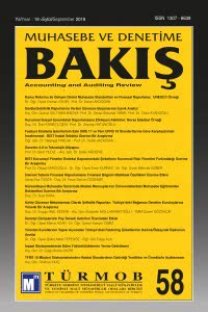IFRS TFRS 13 STANDARDI KAPSAMINDA GERÇEĞE UYGUN DEĞER ÖLÇÜTÜ VE VERGİ USUL KANUNUNDAKİ DEĞERLEME ÖLÇÜTLERİYLE ÖRTÜŞTÜĞÜ DURUMLAR
Finansal raporlamada varlık ve borçların gerçeğe uygun değerle raporlanması günümüz muhasebe uygulamalarında yaygınlaşmıştır. Birçok muhasebe standardında gerçeğe uygun değerle ölçüm esası benimsenmiştir. Gerçeğe uygun değerin farklı standartlarda tanımlanmış olması zaman zaman bazı farklı yorumlara ve karmaşayaneden olmuştur. Bu amaçla gerçeğe uygun değerle ölçümleme esaslarının bir arada toplu olarak görülmesini teminen ‘’TFRS 13 Gerçeğe Uygun Değer Ölçümü ‘’standardı yayımlanmıştır. 2013 yılı başında yürürlüğe girenbu standardın kapsamı ve gerçeğe uygun değerin tesbitinde kullanılacak fiyatın nasıl hesaplanacağı hususu bumakalede incelenmiştir. Ayrıca Türkiye vergi mevzuatındaki değerleme ölçülerinin gerçeğe uygun değer ölçütüile karşılaştırması yapılarak farklı düzenlemelerin örtüştüğü durumlar incelenmiştir
Anahtar Kelimeler:
Gerçeğe Uygun Değer, TFRS 13, Vergi
It is getting more common in actual accounting practice to report the financial assets and liabilities with the fair values. In most of the accounting standards the fair value is accepted that as the base measurement criteria.Having the definition of fair value in different accounting standards sometimes cause confusions and differentinterpretations. Accordingly, in order to provide a common understanding for the measurement with fair value,the Standard namely “TFRS 13 Fair Value Measurement” was issued. Within the context of this article, the scope of this Standard that was enforced in the beginning of 2013 and the principles for determining the price during fair value measurement are analysed. Moreover by making comparisons with the valuation principles stated in the Turkish tax legsilation with the fair value concept, the interstection points of different regulations areanalysed
Keywords:
Fair Value, TFRS 13, Tax,
___
- ALEXANDER David, (2007), “Recent History of Fair Value”, The Routledge Companion to Fair Value and Fi- nancial Reporting, Edited by Peter Walton, Routledge, USA, ss. 71-90
- BROMWICH Micheal, (2007), “Fair Values: Imaginary Prices, Mystical Markets”, The Routledge Companion to Fair Value and Financial Reporting, Edited by Peter Walton, Routledge, USA, ss.46-67
- CAIRNS David, (2007), “The Use of Fair Value in IFRS”, The Routledge Companion to Fair Value and Finan- cial Reporting, Edited by Peter Walton, Routledge, USA, , s.9-23
- FASB, (2006), ASB 157 Fair Value Measurements
- POROY ARSOY Aylin , SELVİ Yakup; ‘’Kobıi Muhasebe Standartlarında Gerçeğe Uygun Değerle Ölçümün Ye- ri’’ Muhasebe Öğretim Üyeleri Bilim Ve Dayanışma Vakfı ,9. Uluslararası Muhasebe Konferansı , İstanbul Tica- ret Üniversitesi 4-5 Ekim 2012
- ŞENSOY Necdet,PEREK Atilla; (2010);’’Kobiler için uluslararası finansal raporlama standardı ve vergi usul ka- nunundaki değerleme esaslarına toplu bakış’’ VII. Muhasebe Uygulamaları ve Vergi Sempozyumu,Antalya,s78.
- TOKAY Hüseyin Semih, DERAN Ali; (2008); “Türkiye Muhasebe ve Finansal Raporlama Standartlarında De- ğerleme Ölçütleri”, Mali Çözüm, sayı 90
- Uluslararası Finansal Raporlama standartları (IFRS/IAS) ile uyumlu TFRS , 2011
- IFRS(TFRS)13 Gerçeğe Uygun Değer Ölçümü Vergi Usul Kanunu
- ISSN: 1307-6639
- Yayın Aralığı: Yılda 3 Sayı
- Başlangıç: 2000
- Yayıncı: TÜRMOB
Sayıdaki Diğer Makaleler
TÜRKİYE’DE BAĞIMSIZ DENETÇİLERİN HİLE RİSK FAKTÖRLERİ ETKİ DEĞERLEMESİ
ETİK LİDERLİK VE ÖRGÜTSEL BAĞLILIK İLİŞKİSİ: MUHASEBE BÜROLARINDA ÇALIŞANLAR ÜZERİNE BİR ARAŞTIRMA
UMS 12 GELİR VERGİLERİ STANDARDI KAPSAMINDA MALİ KAR VE TİCARİ KAR İLE ERTELENMİŞ VERGİLER
Meral EROL FİDAN, Smmm Hasan CİNİT
KARŞILIKLAR, KOŞULLU BORÇLAR VE KOŞULLU VARLIKLARIN TMS 37 STANDARDI KAPSAMINDA İNCELENMESİ
